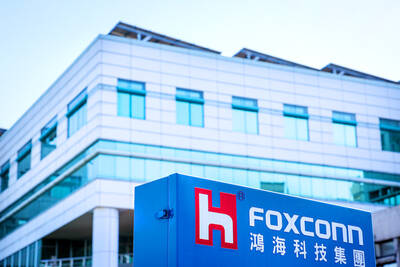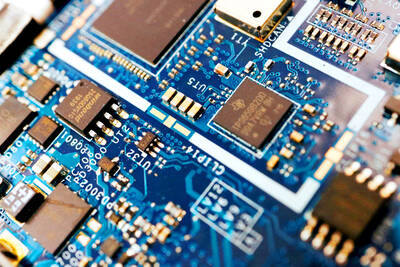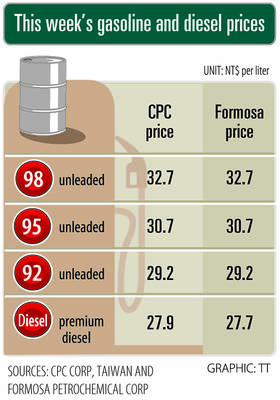The global chip industry is poised for a significant rebound this year with sales expected to jump to a record level, fueled by a greater need for the electrical components from a broad range of businesses, according to a forecast from the Semiconductor Industry Association (SIA).
Worldwide sales declined 8.2 percent to US$526.8 billion last year, although the fall was mitigated by improving conditions in the second half of the year, the association said yesterday in a statement. The increasing momentum indicates sales will gain 13 percent this year to almost US$600 billion, the SIA said.
“Global semiconductor sales were sluggish early in 2023 but rebounded strongly during the second half of the year, a trend we expect to continue in 2024,” SIA president and chief executive officer John Neuffer said. “With chips playing a larger and more important role in countless products the world depends on, the long-term outlook for the semiconductor market is extremely strong.”

Photo: EPA
At the heart of the industry’s growth is Nvidia Corp, the most valuable chipmaker, which avoided the downturn with its market-leading artificial intelligence (AI) accelerators. Those chips are in high demand because they can handle the huge amounts of data that companies need to develop AI models.
Nvidia’s sales are projected to more than double to almost US$60 billion in the fiscal year that ended last month. Analysts project the company’s annual revenue will top US$90 billion by January 2025.
Investors are looking at the promise of future growth, particularly at chipmakers like Nvidia that they think will benefit from the boom in AI-related hardware spending. The Philadelphia Stock Exchange Semiconductor Index, which rallied 65 percent last year, was up 3.9 percent this year through Friday’s close.
Still, some of the industry’s largest companies had a difficult 2023 and posted steep declines in sales as customers cut back on orders while working through bloated inventory stockpiles. A few members of that group, including Intel Corp and Qualcomm Inc, are saying that markets are returning to normal buying patterns and the worst of the contractions are over.
According to Neuffer, the weak first half of last year was a “hangover” from the pandemic, when electronics makers struggled to get enough supply and faced unprecedented demand. That provoked many customers to order too much and find themselves caught in a glut when the economy returned to normal and purchases of devices such as personal computers slowed.
By region, Europe was the only area that posted growth last year as sales increased 4 percent. China and the Asia Pacific region posted the steepest declines, with China revenue, the biggest block of sales for the industry, down 14 percent. In the Americas, the market contracted 5.2 percent.

Hon Hai Precision Industry Co (鴻海精密) yesterday said that its research institute has launched its first advanced artificial intelligence (AI) large language model (LLM) using traditional Chinese, with technology assistance from Nvidia Corp. Hon Hai, also known as Foxconn Technology Group (富士康科技集團), said the LLM, FoxBrain, is expected to improve its data analysis capabilities for smart manufacturing, and electric vehicle and smart city development. An LLM is a type of AI trained on vast amounts of text data and uses deep learning techniques, particularly neural networks, to process and generate language. They are essential for building and improving AI-powered servers. Nvidia provided assistance

DOMESTIC SUPPLY: The probe comes as Donald Trump has called for the repeal of the US$52.7 billion CHIPS and Science Act, which the US Congress passed in 2022 The Office of the US Trade Representative is to hold a hearing tomorrow into older Chinese-made “legacy” semiconductors that could heap more US tariffs on chips from China that power everyday goods from cars to washing machines to telecoms equipment. The probe, which began during former US president Joe Biden’s tenure in December last year, aims to protect US and other semiconductor producers from China’s massive state-driven buildup of domestic chip supply. A 50 percent US tariff on Chinese semiconductors began on Jan. 1. Legacy chips use older manufacturing processes introduced more than a decade ago and are often far simpler than

STILL HOPEFUL: Delayed payment of NT$5.35 billion from an Indian server client sent its earnings plunging last year, but the firm expects a gradual pickup ahead Asustek Computer Inc (華碩), the world’s No. 5 PC vendor, yesterday reported an 87 percent slump in net profit for last year, dragged by a massive overdue payment from an Indian cloud service provider. The Indian customer has delayed payment totaling NT$5.35 billion (US$162.7 million), Asustek chief financial officer Nick Wu (吳長榮) told an online earnings conference. Asustek shipped servers to India between April and June last year. The customer told Asustek that it is launching multiple fundraising projects and expected to repay the debt in the short term, Wu said. The Indian customer accounted for less than 10 percent to Asustek’s

Gasoline and diesel prices this week are to decrease NT$0.5 and NT$1 per liter respectively as international crude prices continued to fall last week, CPC Corp, Taiwan (CPC, 台灣中油) and Formosa Petrochemical Corp (台塑石化) said yesterday. Effective today, gasoline prices at CPC and Formosa stations are to decrease to NT$29.2, NT$30.7 and NT$32.7 per liter for 92, 95 and 98-octane unleaded gasoline respectively, while premium diesel is to cost NT$27.9 per liter at CPC stations and NT$27.7 at Formosa pumps, the companies said in separate statements. Global crude oil prices dropped last week after the eight OPEC+ members said they would